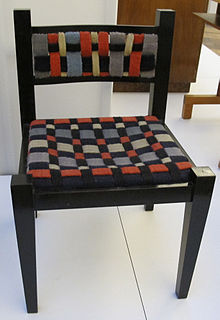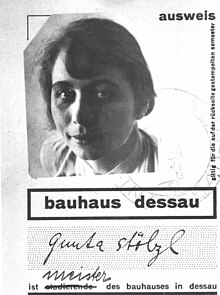Gunta Stölzl

Gunta Stölzl (born March 5, 1897 in Munich as Adelgunde Stölzl ; † April 22, 1983 in Männedorf , Switzerland ) was a weaver and textile designer . She is considered to be a innovator in the art of hand weaving and was the first female master at the Bauhaus . Her works are shown in solo exhibitions and are part of international art collections.
Life
Gunta Stölzl was the daughter of the teacher and school principal Franz Seraph Stölzl and Kreszenz Stürzer. Her father was friends with the reform pedagogue Georg Kerschensteiner . Her brother Erwin was a lawyer. After graduating from secondary school in Munich, Stölzl entered the Royal School of Applied Arts in Munich in 1914 . From 1917 to 1918 she served as the Red Cross Sister on the Isonzo Front in present-day Slovenia and on the Western Front in France .
After her return she was accepted at the Bauhaus in Weimar in 1919 . Stölzl made friends with Marcel Breuer , who came to the Bauhaus in 1920. In 1921 she designed together the African chair and made in the workshop for weaving at the Bauhaus back and seat. 1921-1922 she designed, among other substances for the Sommerfeld House by Walter Gropius . In 1922/1923 she passed the journeyman's examination and, together with other female students, contributed to the establishment of the “women's class”.
In 1924 she took courses in dyeing and production methods at the technical college for the textile industry in Krefeld. In the same year Stölzl set up the Ontos hand-weaving workshops for Johannes Itten in Herrliberg on Lake Zurich . In 1925 she returned to the Bauhaus Dessau and became foreman of the weaving workshop, which she managed as the sole responsible junior master from 1927 after Georg Muche left. During this time she continuously built up company contacts for the manufacture and sale of Bauhaus fabrics.
After a trip to Moscow together , in which the Bauhaus student Peer Bücking also took part in 1928, she married the architect Arieh Sharon in early August 1929 . Their daughter Yael was born on October 8, 1929. In 1931, Gunta Stölzl was forced to quit her job due to political and internal Bauhaus conflicts and left the Bauhaus in October 1931. She lost her German citizenship when she married. After emigrating to Switzerland , she and Bauhaus graduates Gertrud Preiswerk and Heinrich Otto Hürlimann founded the hand-weaving mill SPH-fabrics in Zurich that same year . Among other things, the company manufactured carpets and upholstery fabrics for home use. In 1936 her marriage to Sharon was divorced. From 1937 Stölzl continued to run her weaving workshop alone, now on Florastrasse in Zurich-Seefeld . In 1939 she took part in the Swiss National Exhibition .
In 1942 she married the writer and journalist Willy Stadler, with whom she moved into a terraced house owned by her architect friend Elsa Burckhardt-Blum in Küsnacht . A year later, their second daughter Monika was born. She produced tapestries in the 1950s . Having become a Swiss citizen through her marriage, she continued to work as a textile artist after the Flora hand weaving mill was closed in 1967 .
plant
Gunta Stölzl was "the most important weaver at the Bauhaus, who helped carry out and influenced the weaving process from a pictorial individual piece to a modern industrial design". The special issue of the Bauhaus magazine , which was dedicated to her when she left the Bauhaus, noted: “It is thanks to her that people talk about 'Bauhaus materials'”.
The training and production of the weaving workshop focused on the production of textiles for the new interior. It emerged Furniture spannsstoffe, fabrics for cushions or clothing, wall hangings and rugs. Their colors and patterns corresponded to the characteristic Bauhaus style, which was particularly influenced by the discussions with Johannes Itten, Paul Klee and Wassily Kandinsky . Floor carpets , wall hangings , knotted carpets and curtains made by Stölzl from his time at the Bauhaus in Weimar have been preserved as drafts, in the original design or as rewoven. In Dessau , Gunta Stölzl introduced the field of industrial design in the weaving workshop she heads . Her teaching program for weaving in 1931 provided the basis for the introduction of new, functional textiles. Their production represented an alternative to the program of the Weimar workshop, which was also increasingly based on aesthetic principles. The concept of combining functionality and aesthetic demands of textiles continued to have an effect in their Zurich production, in that the hand-weaving mill SPH fabrics produced a large number of high-quality consumer materials manufactured. These were shown at the Swiss National Exhibition of 1939, among others.
The so-called baffle ceilings also date from the Dessau period (1931) . These were bed throws that were created for the bed niches in the " Prellerhaus ". More than 100 pieces were made at the time, none of which exist anymore - except in photos. At the end of 1990 some copies were produced again.
Since 1967 Gunta Stölzl has been making tapestries in her studio exclusively based on her own designs . In these she interwoven various materials such as yarn , raffia , knotted stones and glass beads . In some tapestries, tightly woven sections are pierced with slits. Characteristic are the adjoining colored areas, which take up geometric and natural forms and combine in the overall view to create landscapes or plant structures.
Solo exhibitions
The following solo exhibitions have been shown in Germany and Switzerland so far:
- “Tapestries by Gunta Stölzl.” Zurich, Lyceumclub, 1970.
- “Tapestries by Gunta Stölzl.” Zurich, Paulus Academy
- "Gunta Stadler-Stölzl - Tapestries and Designs 1921–1976". Bauhaus Archive Berlin, 1976.
- "Gunta Stölzl - tapestries." Stuttgart , Galerie Lutz, 1977.
- “Gunta Stadler-Stölzl - Tapestries.” Zurich, Paulus Academy, 1980.
- "Gunta Stölzl - weaving at the Bauhaus and from my own workshop." Traveling exhibition, Bauhaus Archive Berlin, 1987.
- Bad Säckingen, Villa Berberich , 1988.
Museums
Gunta Stölzl's works are part of international art collections :
- Museum of Modern Art , New York
- Metropolitan Museum of Art , New York
- Busch-Reisinger Museum , Harvard University
- The J. Paul Getty Museum , Malibu, California
- Detroit Institute of Arts , Detroit, Michigan
- Misawa Homes' Bauhaus Collection , Tokyo
- Victoria and Albert Museum , London
- Weimar art collections
- Bauhaus Dessau Foundation
- Bauhaus Archive - Museum of Design, Berlin
- New Munich Collection
- Museum for Art and Cultural History of the Hanseatic City of Lübeck
- State Gallery Stuttgart
- Museum for Design Basel
- Basel Art Association
- Museum of Design , Zurich
Fonts
Gunta Stölzl wrote several writings about the Bauhaus weaving and the Bauhaus, some of which are rare evidence of its early days, as well as an obituary for Paul Klee . Her unpublished writings include the diaries from 1915–1917, 1917–1919 and 1919–1920, children's records 1929–1946 and travel notes 1928–1946. In addition, transcripts of the lectures she attended at the Munich School of Applied Arts and the Bauhaus were preserved, as well as records of the technology of the loom system , the weaving workshop's teaching program and her own weaving lessons. Her extensive letter exchange with relatives, friends and fellow artists is previously unreleased.
literature
- Bauhaus-Archiv, Museum für Gestaltung (Ed.), Magdalena Droste, Jeannine Fiedler (Red.): Experiment Bauhaus: the Bauhaus-Archiv, Berlin, visiting the Bauhaus Dessau. Berlin 1988.
- Anja Baumhoff: Prevented careers in the upheaval of times. Gunta Stölzl (1897-1983). In: Inge Hansen-Schaberg (Ed.): Women of the Bauhaus during the Nazi era. Persecution and exile. edition text + kritik, Munich 2012 ISBN 978-3-86916-212-6 pp. 51–68.
- Annie Bourneuf: A speculative tapestry. Gunta Stölzl's “slit tapestry red-green”. In: Bauhaus model. Ed .: Bauhaus Archive, Berlin in cooperation with: Museum of Modern Art , New York; Catalog Red .: Wolfgang Thöner et al. Ostfildern 2009, pp. 221–238.
- Magdalena Droste (ed.): Gunta Stölzl - weaving at the Bauhaus and from own workshop. Exhibition catalog. Berlin 1987.
- Charlotte and Peter Fiell (eds.): Design of the 20th century. Taschen, Cologne 2012, ISBN 978-3-8365-4107-7 , p. 671.
- Stephan Maus : Ms. Bauhaus. In: Stern . No. 7, 2019, pp. 86-90. (With large-format illustrations, including the whole weaving class)
- Ingrid Radewaldt: Gunta Stölzl - pioneer of Bauhaus weaving. Weimar publishing company in the publishing house Römerweg GmbH 2018, ISBN 978-3-7374-0258-3 .
- Barbara Schmid: Gunta Stölzl. In: Historical Lexicon of Switzerland . May 30, 2012 .
- C. Schwartz: Women with warp and weft. A Berlin exhibition about the textile workshop at the Bauhaus. NZZ , December 14, 1998, p. 28.
- Monika Stadler , Yael Aloni (eds.): Gunta Stölzl: Bauhausmeister. Ostfildern 2009.
- Bauhaus Dessau Foundation (ed.): Gunta Stölzl: Master at the Bauhaus Dessau: textiles, textile designs and free work 1915–1983. Text Ingrid Radewaldt, Monika Stadler u. a. Ostfildern 1997.
- Gunta Stölzl: “Where there is wool, there is also a woman.” In: Die Welt , special issue 90 years of Bauhaus , July 19, 2009, p. 9.
- Woven pictures and fabrics. The textile artist Gunta Stölzl in Dessau. In: NZZ , December 13, 1997, p. 45.
- Sigrid Wortmann Weltge: Bauhaus textiles: art and artists in the weaving workshop. Schaffhausen 1993.
- Gunta Stölzl . In: Patrick Rössler , Elizabeth Otto : Women at the Bauhaus. Pioneering modern artists. Knesebeck, Munich 2019. ISBN 978-3-95728-230-9 . Pp. 22-27.
Web links
- Literature by and about Gunta Stölzl in the catalog of the German National Library
- Barbara Hohl ,: Stölz-Stadler, Gunta. In: Sikart
- Annette Bußmann: Gunta Stölzl. In: FemBio. Women's biography research (with references and citations).
- The Gunta Stölzl Foundation
- Gunta Stölzl on www.bauhaus100.de
- Gunta Stölzl: In the textile workshop of the Bauhaus 1919 to 1931. In: Das Werk , 55, 1968
- Article in Die Welt , July 19, 2009, by Christoph Stölzl
- Article in Emma , September 1, 2009, by Ingrid Radewaldt
Individual evidence
- ↑ Ulla Rogalski: Design history: The "African chair". In: Handelszeitung . October 20, 2005, accessed December 26, 2018 .
- ^ Bröhan, Berg: Design Classics 1880–1930. 2001, p. 84.
- ↑ Ulrike Müller: Bauhaus women - masters in art, craft and design . Elisabeth Sandmann Verlag, 2009, ISBN 978-3-938045-36-7 .
- ↑ Annette Bußmann: Gunta Stölzl. In: FemBio. Women's biography research (with references and citations).
- ↑ Magdalena Droste: Bauhaus. 1991, p. 253.
- ^ Magdalena Droste: Gunta Stölzl and the development of Bauhaus weaving. In: dies., Gunta Stölzl. Weaving at the Bauhaus and from our own workshop. 1987, p. 9.
- ↑ See photo on The Gunta Stolzl Foundation .
- ↑ See photo on The Gunta Stolzl Foundation .
- ↑ On Stölzl's countless participations in exhibitions, cf. Bauhaus Dessau Foundation: Gunta Stölzl: Master at the Bauhaus Dessau. 1997, p. 257.
- ↑ An overview of the pieces contained in the collections in: Bauhaus Dessau Foundation: Gunta Stölzl: Meisterin am Bauhaus Dessau. 1997, p. 259.
- ↑ A selection of the contributions from 1926–1975 is printed in: Droste: Gunta Stölzl - Weberei am Bauhaus and from my own workshop. 1987, pp. 97-106.
- ↑ Copies of these are in the Bauhaus-Archiv / Museum für Gestaltung in Berlin. Excerpts from the diaries are printed in: Stadler, Aloni: Gunta Stölzl. Bauhaus master. 2009.
- ↑ On the unpublished writings of Gunta Stölzl cf. Bauhaus Dessau Foundation: Gunta Stölzl: Master at the Bauhaus Dessau. 1997, p. 262.
| personal data | |
|---|---|
| SURNAME | Stölzl, Gunta |
| ALTERNATIVE NAMES | Stölzl, Adelgunde (maiden name) |
| BRIEF DESCRIPTION | German-Swiss weaver and textile designer |
| DATE OF BIRTH | March 5, 1897 |
| PLACE OF BIRTH | Munich |
| DATE OF DEATH | April 22, 1983 |
| Place of death | Männedorf , Switzerland |

